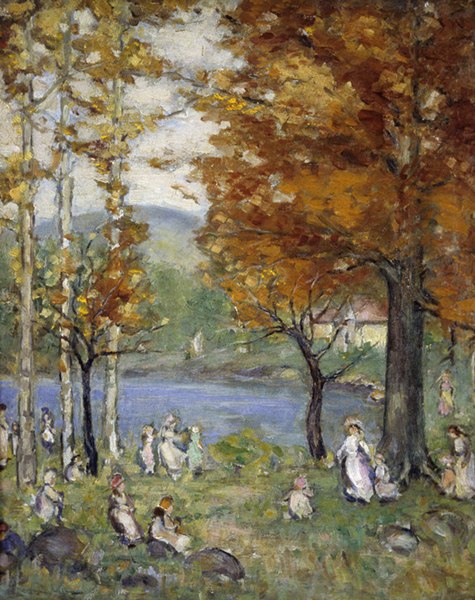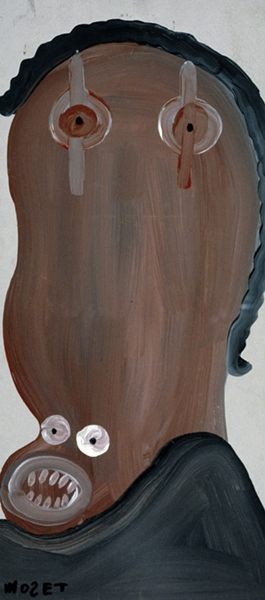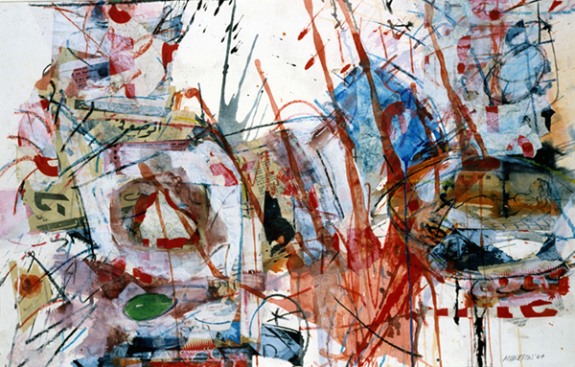Black History Month: Herring, Tolliver, Middleton
I’m kicking off National Black History Month with artists I find fascinating. Their styles are extraordinary, and their names are probably not on the tips of every art historian’s tongue—James V. Herring, Mose Tolliver, and Sam Middleton. Both Herring and Middleton were considered important enough to be included in the landmark exhibition, Two Centuries of Black American Art. This was one of the earliest traveling exhibitions showcasing African American artists—a turning point in giving African Americans more recognition in galleries and museums.
 |
| James V. Herring (1887–1969, United States), Campus Landscape, 1924. Oil on canvas, 12" x 10" (30.5 x 25.4 cm). Private Collection. From the exhibition Two Centuries of Black American Art. Image courtesy of the Los Angeles County Museum of Art. (8S-21864) |
Artistically, Herring was trained in the academic manner of painting. However, in the first decade of the 1900s, French Impressionism had taken hold among many American painters, even though it had evolved in France in the 1870s. It was Impressionism that most informed Herring’s painting style. This view of Howard University students at the campus reservoir is imbued with the high-key, pure colors of Impressionism. It also contains the wispy brushwork and the fuzzy background typical of Impressionism. Even the composition with indistinct sailboats in the distance is reminiscent of French Impressionism.
Herring was a highly influential leader in promoting African American artists in the South during the same period as the Harlem Renaissance. Herring was born in Clio, South Carolina. He studied at Syracuse, Columbia, and Harvard Universities. In 1921, he became an instructor at Howard University, a historically Black university in Washington, DC. He ran the newly established art department until 1943.
Along with former student and colleague, Alonzo J. Aden (1906–1961), Herring opened the Barnett-Aden Gallery in Washington, DC. The gallery sought to promote the art of little-known African American artists. In order to establish a blindness to race, white artists were also exhibited there, making it the first integrated art gallery in the United States to exhibit white and Black artists side-by-side.
 |
| Mose Tolliver (1916/1921–2006, United States), Mask. Housepaint on panel, 26 ¾" x 12 ⅝" (68 x 32 cm). University of Central Florida, Orlando. Image by Dr. Maude Wahlman. © 2025 Artists Rights Society (ARS), New York. (8S-29032tolars) |
Perhaps created as a connection leading back to his African ancestors, Tolliver produced many close-ups of heads that he titled Mask. In composition, mask images such as this certainly bear a resemblance to the simplification and exaggeration of African masks from many cultures. It must be borne in mind that African masks were one of the inspirations for the earliest of Western abstract artists, particularly the Cubists like Pablo Picasso (1881–1973). However, there is no evidence that Tolliver ever saw African masks, or Picasso’s work for that matter.
Tolliver’s abstraction is linked to the disconnect between his personal fantasy and the source of what he depicted. He loved painting and often said he painted “what was in my head.” Although his palette was usually limited to two or three colors, the scheme is always harmonious and shows a sophisticated aesthetic. Mask displays the artist’s typical distortion of the human head with the bulbous upper part, extended mouth-cave, and nostrils that seem to form a secondary face.
Born in Pike Road, Alabama, Tolliver was the youngest of seven sons in a family of twelve children. He attended school until the third grade. Disinterested in school, Tolliver began working on the family farm. Later he recalled that his family house, a “shack,” had walls covered in pictures his mother created. After his father died, Tolliver moved with his mother to Montgomery, Alabama, where he took jobs in landscaping. He developed a solid reputation for his artistic flair in landscaping and gardening.
From the 1940s to late 1960s, Tolliver worked in a furniture factory, where he was disabled by an accident. In the early 1970s, on the advice of his former employer, Tolliver began to experiment with painting as a rehabilitative occupation. He had an epiphany and subsequently answered what he considered an “inner voice” that urged him to be an artist. Tolliver would paint any surface available to him such as tabletops, plywood crates, board remnants, and Masonite. He began with readily available house paint, oil-based at first and then latex. He termed such paint “pure paint.” His subjects were figures, animals both fantastical and real, and flowers.
At first, Tolliver sold his works from his front porch. In 1980, he attracted the attention of Mitchell Kahan, a former curator from the Montgomery Museum of Fine Arts. The following year, the museum mounted a one-person show of his work. Robert Bishop, director of the American Folk Art Museum at the time, compared Tolliver’s “creativity and deep personal vision” to the abstractions of Picasso in a Montgomery Advertiser article. The article garnered the attention of the “art world,” and Tolliver’s work was included in the landmark exhibition Black Folk Art in America, 1930–1980, organized by the Corcoran Art Gallery in 1982.
 |
| Sam Middleton (1927–2015, United States), Composition, 1970s. Mixed-media and collage on paper, 20 ¾" x 31" (52.7 x 78.8 cm). The University Galleries, Fisk University, Nashville. From the exhibition Two Centuries of Black American Art. Image courtesy of the Los Angeles County Museum of Art. © 2025 Artist or Estate of Artist. (8S-21971) |
Classical and jazz music remained constant influences on Sam Middleton's painting throughout his career in the Netherlands. Although he delighted in painting landscapes in the north of Holland, where he ultimately settled permanently, his work is mostly characterized by fluid, energetic line. Middleton would also included references to figurative artists of the past, as he did in this Composition. He also added collage elements to his many of works. These abstract artworks, which depict the rhythms, lines, and colors of sound and harmony, reflect the influence of the European version of Abstract Expressionism, called Art Informel.
Middleton was born in Harlem, New York City, at the height of the Harlem Renaissance. As a young man, he often visited the famed Savoy Ballroom, and both jazz and classical music became important inspirations for his painting. At the Savoy, Middleton designed costumes and painted cover designs for books and albums, reflecting the musicians he had met. At seventeen, he joined the Merchant Marines, which allowed him not only to get away from the racism and class inequality of America, but also to see various parts of the world.
While in Europe, Middleton visited art museums and galleries for inspiration, finding Europe a much more accepting environment for an African American artist. In 1956, Middleton left the Merchant Marines to study art at the Allende Institute in San Miguel de Allende, Mexico, where he honed his technical skills. In 1959, he returned to Europe to paint, ultimately setting in the Netherlands for good. He was part of a wave of African American artists who settled there. Because he had moved to escape racism in the United States, Middleton’s work did not reflect the Black experience in America. Because he was not part of the Civil Rights Movement or Spiral—the African American contemporary artists’ alliance (active 1963–1965)—his work was not widely represented in collections of African American artists' work.
Correlations to Davis programs: Davis Collections: African American Art pre-1920; Davis Collections: Collage; Davis Collections: Visionary / Self-Taught Artists; Davis Collections: Western Art Styles – Impressionism

Comments